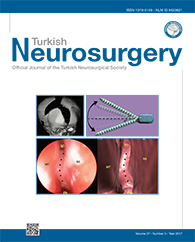2Urmia University of Medical Sciences, Faculty of Medicine, Graduated from Department of Anatomy, Postgraduate Masters from Department of Anatomy, Urmia, Iran
3Urmia University of Medical Sciences, Faculty of Medicine, Neurophysiology Research Center, Department of Physiology, Urmia, Iran DOI : 10.5137/1019-5149.JTN.16004-15.2 AIM: The aim of this study was to evaluate the effect of cerebrospinal fluid (CSF) in nerve regeneration across the collagen guide channel in comparison with autograft.
MATERIAL AND METHODS: Forty adult male rats (250-300 g) were randomized into (1) collagen channel+CSF, (2) collagen channel+normal saline (NS), (3) autograft, and (4) sham surgery groups. The left sciatic nerve was exposed and a 10 mm nerve segment was cut and removed. In the collagen groups, the proximal and distal cuts ends of sciatic nerve were telescoped into the nerve guides and CSF or NS injected into collagen conduit. In the autograft group, the 10 mm nerve segment was turned backwards and used an autologous nerve graft. All animals were evaluated by sciatic functional index (SFI) and electrophysiology, histology, and immunohistochemistry testing.
RESULTS: The improvements in SFI since the beginning of the last evaluation in experimental groups were measured. On days 49 and 60 post-operation, the mean SFI of the collagen+CSF group was significantly greater than the autograft group (P< 0.05). On day 90, the mean nerve conduction velocity (NCV) of the collagen+CSF group was greater than autograft group (P< 0.05). The number of myelinated fibers in the collagen+CSF group was significantly greater than that of the collagen + NS group at day 90 (P<0.05).
CONCLUSION: CSF in collagen nerve guide channel effectively enhances nerve regeneration and promotes functional recovery in injured sciatic nerve of rats.
Keywords : Sciatic nerve, Collagen, Nerve guide channel, Cerebrospinal fluid, Rat




